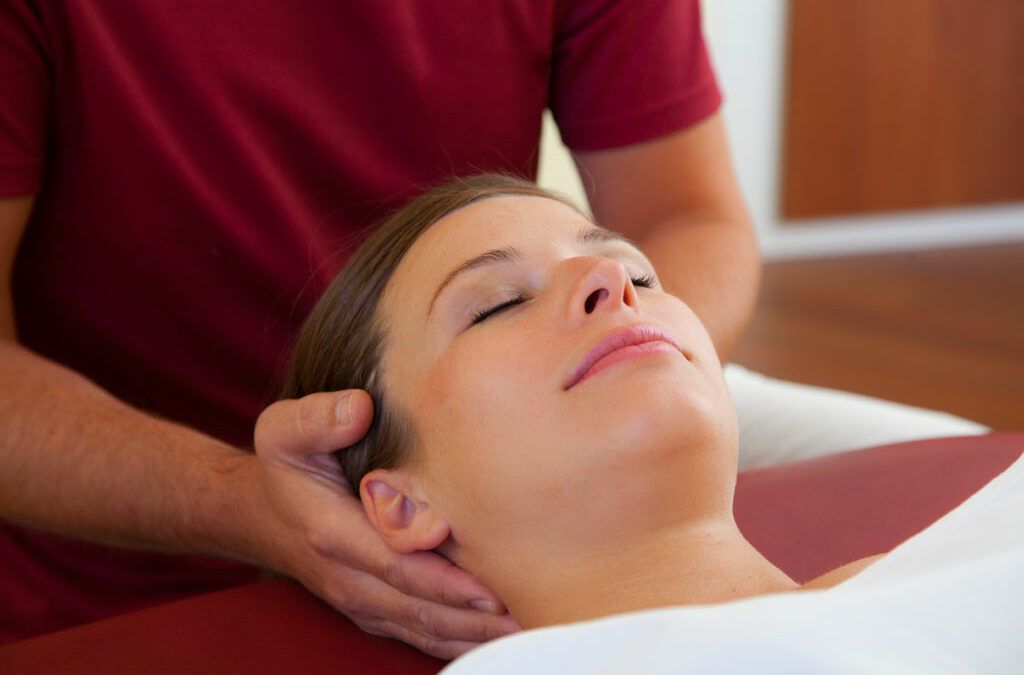What is cranial osteopathy?
Cranial osteopathy is a form of gentle osteopathic treatment. It allows the release of deep-seated tension from the body using soft techniques.
In ‘Cranial’ osteopathy is a real misnomer. It suggests that we only treat the head. The treatment is to the whole body. It is a very effective way of treating a variety of problems suffered by people of all ages.
About Osteopathy
Osteopathy is a philosophy of health. It is not just a set of techniques applied to the body. Problems arising in the musculoskeletal system can affect your health in different ways.
Mechanical and functional problems can lead to pain in joints and muscles. It can also affect internal organs and their function. Osteopaths’ work aims to establish balance in the body to optimise a person’s self-healing and self-regulating mechanism.
Health
Health is not just the absence of illness and pain. It is a state of balance and harmony in a person’s mind and body. A healthy person should be able to compensate well to any insults such as illness, accidents, infections and emotional stress without suffering the accumulative effect of such experiences.
Sometimes people are unable to let go of some of the strains caused by the knocks and bump (stress) accumulated throughout their life. When one stress is followed by another stress, the body can feel overwhelmed (allostatic load). This is how health can become compromised and pain and/ or loss of function may ensue. We can call this ‘the straw that broke the camel’s back’.
What does a cranial osteopath do that is different?
An osteopath use various techniques in their treatments. From the more direct manipulations (‘the techniques that makes a joint ‘pop’ a.k.a. high velocity low amplitude thrust) to the gentle techniques used by the cranial osteopath.
A cranial osteopath works with more delicate techniques that are suitable for problems that are more complicated or for people who are delicate, either due to age or illness. An osteopath will always use techniques according to the person’s needs. Many osteopaths specialise in sports injuries or treatment of viscera. Cranial osteopathy crosses over all specialties and suitable for everyone, even an injured athlete.
Why pain can occurs
When we are ill, tired, stressed or have a new injury our nervous system detects pain. We are more sensitive to pain stimulus from previous injuries. This is why people often get reccurent musculoskeletal pain in the same places of the body even when there has not been a recent injury. Pain often blamed on ‘bad posture. Recent pain science suggests that this is not the case. Posture has little to do with why we get pain. Our nervous system has simply become more sensitive to pain stimulation.
Through gentle treatment and introduction of movement and exercise we can reduce the pain stimulation. We cannot correct old injuries that have caused structural damage to bones and joints. Sadly there is a myth that osteopaths ‘put bones into place’. That is not true. We can help improve how your body and tissues function and reduce pain which can in turn improve your health and well-being.
An example
Linda is 12 years old. One day she falls down from a tree and lands on her bottom. She is bruised and sore a few days afterwards, but forgets all about it. What she is unaware of is that she has withheld strain that compromises the tailbone, the pelvis and the top of her neck. At 20 years of age, Linda has a road traffic accident and gets a mild whiplash. All road traffic accidents cause an enormous strain through the back and the spine, which is added on top of what happened to her as a child.
Age 30, Linda is going through a stressful time at work and she starts having low back pain and headaches. Linda decides to see an osteopath. Through gentle treatment the tension is eased and her body returns to a state of comfort where function is improved and pain is reduced. Linda has no more headaches or back pain, she has more energy, sleeps better and is more able to cope with the stress at work.
What does treatment entail
The osteopath will take a careful history and do a thorough examination before diagnosing the problem and explain how the symptoms may have come about. The accumulated strain and tension will gradually subside through the treatment process. How long this process take will depend on how long the problem has been there and the underlying state of health of the person.
In a healthy adult with an acute problem (less than a month old), 1 to 3 treatments are usually sufficient to become symptoms-free. However, it may take longer to resolve the cause of the problem, which could have been there for several years.
People who stick with treatment for longer usually find they have more energy and get less ill. This is because unresolved problems require more energy from the body to compensate for it. Once these unresolved issues have resolved, there is more energy for the system to maintain good healthy function.
The osteopath uses gentle handholds at various points of the body like the head, the trunk and the pelvis. The aim is to get the body to function as best it can from the first treatment. In some acute conditions the pain due to inflammation in the tissues can take a few days to subside. Treatment is aimed to help the body resolve the inflammatory state as quickly as possible.
Sometimes after a treatment you might feel symptoms in places that you had not had any symptoms before, or you might get more sore in the painful area you presented with. This usually last for 12-24 hours and is a sign that things have shifted and your body has started the healing process.
How does cranial treatment feel?
The patient can feel a sensation of heat or pressure, either from the osteopath’s hands or in other parts of the body. Sometimes people feel pleasant tingling sensation or waves of sensation in parts of their body.
Most patient’s feel that tension is reduced and then feel a deep sense of relaxation. You may feel sleepy during and after treatment. Even as you lie still, your body is working very hard to self-correct.
What can cranial osteopathy help with?
In osteopathy, we see the person as a whole and we treat the whole, not just the symptoms. Using our osteopathic principles we can help with anything that a person would seek an osteopath for which is usually pain. However, some people find it helpful when they suffer from inability to relax or they have symptoms related to head and neck.
Cranial osteopathy is gentle, it is not bone manipulation as some people may believe. The osteopath has a hands-on ‘conversation’ with the body and feels for release of tension during the treatment and what areas of the body needs attention.
We treat people of all ages, including babies.
If you would like to speak to us about how osteopathy might help you, please feel free to call us and book a 15-minute consultation with one of us at no cost.




